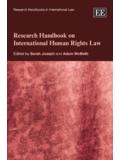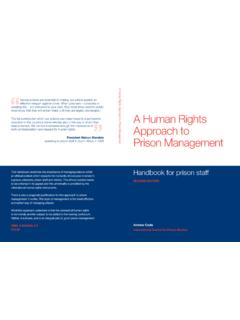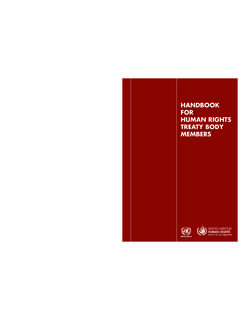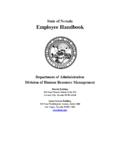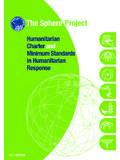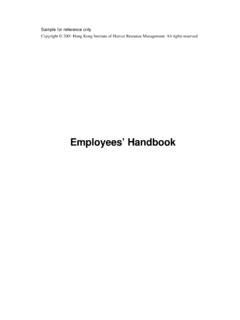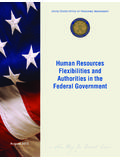Transcription of AFRICAN UNION HANDBOOK 2014 - United Nations
1 AFRICAN UNION HANDBOOK 2014 AFRICAN UNION HANDBOOK 2014 AFRICAN UNION HANDBOOKA GUIDE FOR THOSE WORKING WITH AND WITHIN THE AFRICAN UNIONF irst published in 2014 First edition AFRICAN UNION Commission and New Zealand Crown Copyright Reserved 2014 ISSN: 2350-3319 (Print)ISSN: 2350-3335 (Online)Jointly published by the AFRICAN UNION Commission and New Zealand Ministry of Foreign Affairs and Trade/Manat AorereAfrican UNION PO Box 3243 Roosevelt Street (Old Airport Area), W21K19, Addis Ababa, Ethiopia Website: Email: Ministry of Foreign Affairs and Trade/Manat AorerePrivate Bag 18 901, Wellington, New Zealand Website: Email: PDF version of this book is available on the websites AFRICAN UNION Commission and New Zealand Ministry of Foreign Affairs and Trade shall not be under any liability to any person or organisation in respect of any loss or damage (including consequential loss or damage), however caused, which may be incurred or which arises directly or indirectly from reliance on information in this page 7 AUC 2013, all rights reserved.
2 Any redistribution or reproduction of part or all in any form is prohibited. You may not, except with AUC express written permission, copy, reproduce, distribute or exploit the content. Nor may you transmit it or store it in any other website or other form of electronic retrieval system. Directorate of Information and Communication, AFRICAN UNION Commission image: Courtesy of Getty Images..5 FOREWORDS ..7 Chairperson of the AFRICAN UNION Commission ..7 New Zealand Minister of Foreign .. 8 WHAT THIS BOOK DOES..9 HISTORY OF THE OAU AND AU .. 11 EXECUTIVE COUNCIL..17 SPECIALISED TECHNICAL COMMITTEES ..23 PEACE AND SECURITY COUNCIL ..27 AFRICAN Peace and Security Architecture (APSA) ..28 PSC Subsidiary Early Warning System (CEWS) ..33 Panel of the Wise..34 AFRICAN Standby Force (ASF)..37 Peace Support Operations (PSOs) ..39 Peace Fund ..43 High-Level Panels ..44 AFRICAN UNION COMMISSION ..45 Chairperson..47 Deputy Chairperson.
3 47 Commissioners ..48 Headquarter Units (offices, divisions and departments) ..49 Permanent Representational and Specialised Offices ..60 Special Representative and Liaison Offices ..61 Special Envoys of the Chairperson of the Commission ..64 PAN- AFRICAN PARLIAMENT ..67 JUDICIAL AND HUMAN RIGHTS INSTITUTIONS ..73 AFRICAN Commission on Human and Peoples Rights ..74 AFRICAN Court on Human and Peoples Rights ..78 AFRICAN Court of Justice/ AFRICAN Court of Human Rights and Justice ..80 AFRICAN Committee of Experts on the Rights and Welfare of the Child (ACERWC)..80 FINANCIAL INSTITUTIONS ..83 AFRICAN Central Bank (ACB) ..84 AFRICAN Investment Bank (AIB) ..84 AFRICAN Monetary Fund (AMF) ..853 PERMANENT REPRESENTATIVES COMMITTEE ..87 ECONOMIC, SOCIAL AND CULTURAL COUNCIL ..103 NEW PARTNERSHIP FOR AFRICA S DEVELOPMENT (NEPAD)..109 AFRICAN PEER REVIEW MECHANISM (APRM) ..113 REGIONAL ECONOMIC COMMUNITIES ..117 AFRICAN DEVELOPMENT BANK.
4 129 United Nations ECONOMIC COMMISSION FOR AFRICA ..133 OTHER BODIES RELATED TO THE AU..137 Committee of Intelligence and Security Services of Africa (CISSA)..138AU Advisory Board on Corruption..139AU Commission on International Law (AUCIL).. 140 Treaty Bodies, Specialised Agencies and Other Bodies ..142 EXTERNAL PARTNERSHIPS..153 United Nations Liaison and Representational Offices ..154 Continent and Country Partnerships ..155 Non- AFRICAN States and Organisations accredited to the AU ..157 BUDGET ..159 ACRONYMS ..167 APPENDICES ..17 3 Appendix I: Constitutive Act of the AFRICAN II: Protocol on Amendments to the Constitutive Act of the AFRICAN UNION ..183 INDEX ..1874 ABBREVIATIONSA frican UNION Member State namesUnless otherwise noted, the full names on the left are as listed in the AFRICAN UNION (AU) Constitutive Act of 2000, plus the Republic of South Sudan, which joined the AU in 2011. The names on the right are abbreviations used in this s Democratic Republic of Algeria AlgeriaRepublic of Angola AngolaRepublic of Benin BeninRepublic of Botswana BotswanaBurkina Faso Burkina FasoRepublic of Burundi BurundiRepublic of Cameroon CameroonRepublic of Cape Verde Cape VerdeCentral AFRICAN Republic Central AFRICAN RepublicRepublic of Chad ChadUnion of the Comoros* ComorosRepublic of the Congo CongoRepublic of Cote d Ivoire C te d IvoireDemocratic Republic of Congo DR CongoRepublic of Djibouti DjiboutiArab Republic of Egypt EgyptState of Eritrea EritreaFederal Democratic Republic of Ethiopia EthiopiaRepublic of Equatorial Guinea Equatorial GuineaGabonese Republic GabonRepublic of The Gambia GambiaRepublic of Ghana GhanaRepublic of Guinea Guinea Republic of Guinea Bissau Guinea BissauRepublic of Kenya KenyaLesotho LesothoRepublic of Liberia
5 LiberiaState of Libya* LibyaRepublic of Madagascar MadagascarRepublic of Malawi MalawiRepublic of Mali MaliIslamic Republic of Mauritania MauritaniaNote* Name changed since of Mauritius MauritiusRepublic of Mozambique MozambiqueRepublic of Namibia NamibiaRepublic of Niger NigerFederal Republic of Nigeria NigeriaRepublic of Rwanda RwandaSahrawi Arab Democratic Republic Sahrawi RepublicRepublic of Sao Tome and Principe S o Tom and Pr ncipeRepublic of Senegal SenegalRepublic of Seychelles SeychellesRepublic of Sierra Leone Sierra LeoneRepublic of Somalia SomaliaRepublic of South Africa South AfricaRepublic of South Sudan South SudanRepublic of Sudan SudanSwaziland SwazilandUnited Republic of Tanzania UR of TanzaniaTogolese Republic TogoRepublic of Tunisia TunisiaRepublic of Uganda UgandaRepublic of Zambia ZambiaRepublic of Zimbabwe ZimbabweOther commonly used abbreviationsAU AFRICAN UnionAssembly AU Assembly of Heads of State and Government (unless otherwise specified)Commission AU Commission (unless otherwise specified)Continent Continent and Islands of AfricaECOSOCC AU Economic, Social and Cultural CouncilOAU Organization of AFRICAN UnityPRC AU Permanent Representatives CommitteePSC AU Peace and Security CouncilRECs AFRICAN Regional Economic CommunitiesUN United NationsA fuller list of acronyms is available towards the end of this article 11 of the Protocol to the AU Constitutive Act, the official languages of the AU and all its institutions are Arabic, English, French, Portuguese, Spanish, Kiswahili and any other AFRICAN language.
6 The AU s working languages are Arabic, English, French and THE CHAIRPERSON OF THE AFRICAN UNION COMMISSIONI am delighted to introduce the first official AFRICAN UNION HANDBOOK a comprehensive guide to the AFRICAN UNION system. As we celebrate the 50th anniversary of the Organization of AFRICAN Unity (OAU)/ AFRICAN UNION (AU), and as we engage in the process of conceiving Agenda 2063, it is timely for the AU system to have this HANDBOOK aims to inform Member States, AU Organs, Programmes and Offices as well as the Regional Economic Communities about the purpose, structure and key facts of the AU family. It will be of interest as well to AU partners, civil society and the media. The HANDBOOK contains detailed and factual information about the AU since 2002 and summary information relating to its predecessor, the OAU, which was formed in 1963. It illustrates some of the work that has gone into building AFRICAN unity, prosperity and peace through the AU, the solid achievements of pan-Africanism and pathways to the also provides delegates and officials with detailed insights and understanding of the UNION , upon which we must to base our renaissance.
7 Today, the AU is central to the advancement of Africa. It is the pre-eminent organisation of the continent. I hope that this HANDBOOK will be of valuable assistance to our Member States, citizens and partners as they navigate the AU system. This first edition is available both in hard copy and electronically through our website, This first edition is in English. However, it is intended that the HANDBOOK will in the future also be published in the other working languages of the AU. My sincere gratitude goes to the Government of New Zealand for generously supporting the AU Commission to produce the HANDBOOK . I hope this very practical guide reaches a wide audience and helps readers have a better understanding of the AFRICAN UNION and its role in the development and integration of our mother hope that the experience gathered in the laborious process of midwifing the HANDBOOK will be deployed to enhance our collaborative Dr Nkosazana Dlamini Zuma CHAIRPERSON OF THE AFRICAN UNION COMMISSION Photo AFRICAN UNION Commission Photography7 FOREWORDBY THE NEW ZEALAND MINISTER OF FOREIGN AFFAIRSNew Zealand salutes the countries of Africa on this 50th anniversary year of the formation of the Organization of AFRICAN Unity.
8 New Zealand is proud to contribute to the 50th anniversary celebrations by partnering with the AFRICAN UNION Commission to produce this first edition AFRICAN UNION HANDBOOK . New Zealand has published the annual United Nations HANDBOOK since 1961. We know first-hand the importance of strong global and regional multilateral systems for all states, large and small. I am therefore delighted that we have been able to share our knowledge and experience to jointly produce a HANDBOOK for the AFRICAN UNION members, staff of the Commission and others who follow the work of the UNION . It is a time for those of us outside Africa as well as for the people of the continent to reflect on the outstanding achievements of this organisation as well as the many people it has represented. It is also an opportunity to look ahead and focus on Africa s enormous future potential. Opportunities for Africa to play a key role in global economic growth are unprecedented.
9 At the same time, more than ever before, new generations of Africans are able to look forward to a more peaceful and secure future for themselves and their communities. We trust this HANDBOOK will quickly become a valuable reference tool for every person working in or with the AFRICAN UNION , and for those looking to better understand or increase their participation and engagement with this organisation. This is a first edition. Like the United Nations HANDBOOK , this publication will benefit from regular updates and the use of innovative technology to make its information more accessible to users. Warmest congratulations and best wishes to the AFRICAN UNION as it leads the way into the next 50 years of AFRICAN Murray McCully NEW ZEALAND MINISTER OF FOREIGN AFFAIRS 8 WHAT THIS BOOK DOESThis HANDBOOK is published by the AFRICAN UNION (AU) in partnership with the New Zealand Government, publisher of the annual United Nations HANDBOOK for more than 50 years.
10 Modelled on the United Nations HANDBOOK , it is intended as a ready reference guide for people working in all parts of the AU system (Member States, government officials, Commission staff) as well as the AU s many partners and wider civil society. The book has at its heart information about the principal organs established by the AU Constitutive Act and subsequent protocols: the Assembly, Executive Council, Peace and Security Council, Pan- AFRICAN Parliament, Justice and Financial Institutions, Permanent Representatives Committee and AU Commission. It also contains information about the subsidiary organs and programmes established in accordance with the Constitutive Act as well as regional and other arrangements, such as the Regional Economic Communities, which are closely integrated with the AU. Non-governmental organisations, inter-governmental organisations and political groups are not included except where they have a formal agreement with the HANDBOOK focuses on the AU s current organs and structure and is not intended to be a historical record.










